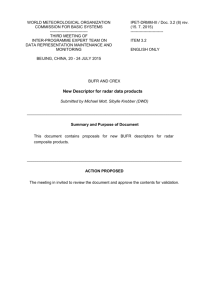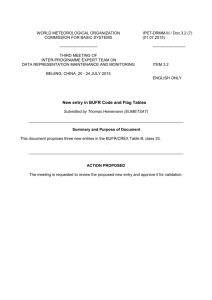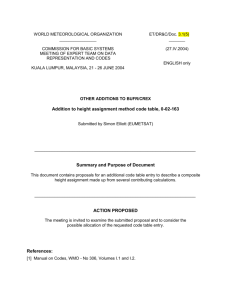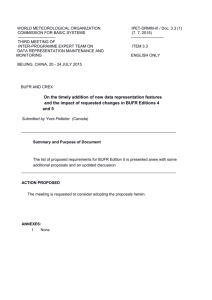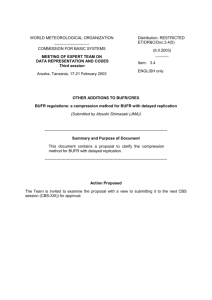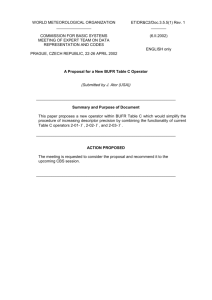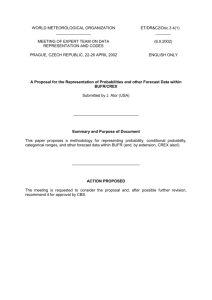Representing WAFS Significant Weather (SIGWX)
advertisement
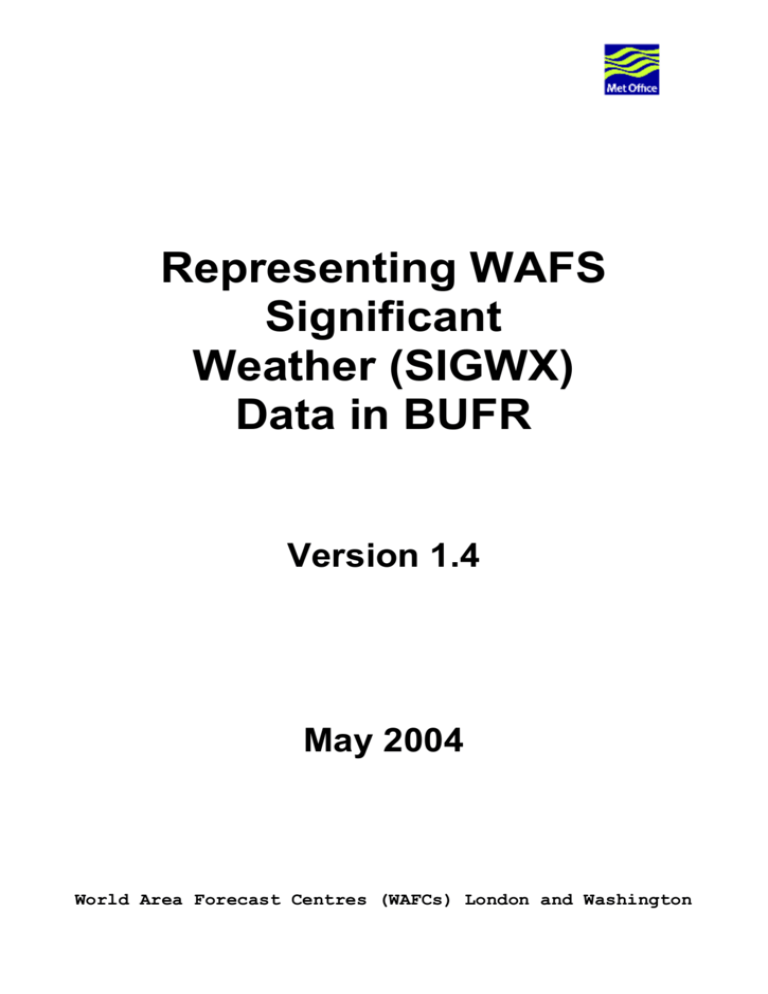
Representing WAFS Significant Weather (SIGWX) Data in BUFR Version 1.4 May 2004 World Area Forecast Centres (WAFCs) London and Washington 1 Table of Contents 1. The BUFR format ............................................................................................................................................................... 4 1.1. INTRODUCTION ............................................................................................................................................................ 4 1.2. SCOPE OF DOCUMENT ................................................................................................................................................ 4 1.3. CONCEPTS ..................................................................................................................................................................... 4 1.3.1. BUFR TABLES ..................................................................................................................................................... 4 1.3.2. REPRESENTATION ............................................................................................................................................. 5 1.3.3. STANDARDS ........................................................................................................................................................ 5 1.3.4. OPEN/CLOSED AREAS ....................................................................................................................................... 5 1.3.5. UNIT CONVERSIONS.......................................................................................................................................... 5 1.3.6. WMO MESSAGE HEADER ID's .......................................................................................................................... 5 2. HEADER Representation .................................................................................................................................................. 6 2.1. MESSAGE HEADER ...................................................................................................................................................... 6 3. Features Represented ......................................................................................................................................................... 6 3.1 4. GENERAL GUIDANCE…………………………………………………………………………………………….…..8 JET STREAM Representation .......................................................................................................................................... 8 4.1. FEATURE HEADER .................................................................................................................................................... 10 4.2. FEATURE DATA ......................................................................................................................................................... 10 5. CAT Representation ......................................................................................................................................................... 10 5.1. FEATURE HEADER .................................................................................................................................................... 11 5.2. FEATURE DATA ......................................................................................................................................................... 11 6. CLOUD Representation ..................................................................................................................................................... 2 6.1. FEATURE HEADER .................................................................................................................................................... 12 6.2. FEATURE DATA ......................................................................................................................................................... 12 7. FRONT Representation ................................................................................................................................................... 14 7.1. FEATURE HEADER .................................................................................................................................................... 14 7.2. FEATURE DATA ......................................................................................................................................................... 14 8. TROP Representation ...................................................................................................................................................... 14 8.1. FEATURE HEADER .................................................................................................................................................... 14 8.2. FEATURE DATA ......................................................................................................................................................... 15 9. VOLCANOES, STORMS and RADIATION Representation ...................................................................................... 15 9.1. FEATURE HEADER .................................................................................................................................................... 15 9.2. FEATURE DATA ......................................................................................................................................................... 15 10. Relevant BUFR Tables ..................................................................................................................................................... 16 11. Contact Details .................................................................................................................................................................. 18 BUFR format for WAFS SIGWX data January 2004 2 DOCUMENT IDENTIFICATION SHEET DOCUMENT DESCRIPTION Document title: Representing WAFS Significant Weather (SIGWX) Data in BUFR. Document Reference Number Issue : 1.4 Date Of Issue : 14/05/2004 Abstract This document provides guidelines for the correct depiction of WAFS SIGWX data from BUFR code produced by the two World Area Forecast Centres. Keywords: WAFS SIGWX BUFR Disk Reference/ File Name : \\exxnas1\userdata$\richard.orrell\MyDocuments\Personal files\Misc Contact : R Orrell (WAFC London) Tel: +44 (0)1392 884892 E-mail: richard.orrell@m etoffice.com DOCUMENT APPROVAL Action Responsibility Name Signature Author Accepted BUFR format for WAFS SIGWX data January 2004 Date 3 DOCUMENT CHANGE RECORD ISSUE DATE REASON FOR CHANGE SECTION PAGES AFFECTED 0.3 Nov. ‘03 All 1.0 21/01/04 1.1 24/03/04 1.2 30/03/04 1.3 15/04/04 1.4 14/05/04 First full draft prepared for joint WAFC BUFR liaison meeting (18/12/03) Final draft incorporating comments from WAFC liaison meeting. Minor word change in BUFR table 020008, and some typos corrected. Deletion of word “Typically” to highlight the fact that only one set of frontal movement info should be assigned to each front within the BUFR bulletin. Change to the use of figure 12 in BUFR table 011031 Modifications to jet depiction taking into account the display of the vertical height information. All 1.1, 3.1, 4 12,13, 15 Section 7.2 Section 10 Section 4 BUFR format for WAFS SIGWX data January 2004 4 1. The BUFR format 1.1. INTRODUCTION BUFR stands for Binary Universal Form for the Representation of meteorological data. It is a standard developed by the World Meteorological Organisation (WMO; see WMO Manual 306 Part B for technical specification, which can be procured via the WMO web site - http://www.wmo.ch/index-en.html) for the efficient storage of meteorological features in a machine independent form, where all the information to describe the features are contained within the data. This document has been prepared by the World Area Forecast Centres (WAFCs) for the purpose of providing guidance to software developers who have the task of constructing WAFS SIGWX BUFR visualisation software. The primary aim of such software should be to decode and display WAFS SIGWX data in a format that is identical to the equivalent WAFS T.4 SIGWX chart in regard to the depiction of the meteorological phenomena (cloud – type and coverage, volcanoes, tropical cyclones, radiation events, C.A.T., jet-streams, and surface fronts), and largely identical to the T.4 product in regard to the display of text boxes (related to areas of cloud, volcanoes, and C.A.T.). It is against this standard that compliances will be measured. ICAO and WMO have asked WAFC London to implement a software review process that involves assessing the quality of WAFS products produced by different visualisation systems against a list of high level criteria set by the ICAO SADIS Operations Group. Subject to the agreement of the owners of the reviewed software packages, the results from these reviews will be displayed on the ICAO and WAFC London web sites, with the purpose of assisting customers in their software procurement process. It should be stressed that this review process is not considered a certification or an endorsement of one product over another, but is simply an objective analysis of the degree of compliance of the software to display WAFS products in a valid manner. By making the list of compliant software packages widely available to States and individual users via ICAO and WMO, it is the intention to use the review process as a mechanism to raise software compliances. The WAFCs have produced this document with the intention of circulating it to all interested parties. If additional guidance or advice in regard to any of the items included in this document is required, then users, software manufacturers and State Authorities are invited to contact WAFC London. A consultancy service is available to assist these users. Please contact Richard Orrell for further information: - E-mail: richard.orrell@metoffice.com Tel: +44(0)1392 884892. 1.2. SCOPE OF DOCUMENT Sections 4 to 9 outline how each feature depicted on a HIGH level WAFS Significant Weather chart (SWH) is represented in BUFR. HIGH level data covers 25,000 - 63,000 feet (FL250 to FL630). Medium level data (SWM) which covers 10,000 - 45,000 feet (FL100 to FL450) includes additional cloud, moderate and severe TURBULENCE (TURB) and ICING data, is scheduled to be available in BUFR format for test and evaluation in late-2004. This document will be updated by this time to include guidance relating to the depiction of these SWM features. Additions and changes to the way in which features are depicted on the SWH charts are scheduled during the next few years. This document will be updated and re-circulated prior to the introduction of these changes. This document outlines the text format used by both the WAFCs to encode and decode HIGH level SIGWX data in BUFR. 1.3. CONCEPTS To produce a BUFR file two elements are needed. 1) A file of raw data and 2) a set of tables containing descriptors. When the raw data is encoded each data value is attached to a descriptor which defines what that data represents. The decoding process reads the BUFR file, looks up the descriptor in the relevant table and writes out the information in whatever format is needed. 1.3.1. BUFR TABLES The binary BUFR files contain a set of tables’ descriptors and a data values. To be able to understand what the values represent the descriptors need to be decoded from a set of common tables that sit on the local machine. This format means that the BUFR messages are very small and are machine independent. They can be understood and decoded by any BUFR decoder which has the latest tables available. The WAFCs use an ASCII file to store the raw data. This file is processed to produce a BUFR message. A similar procedure is used to decode BUFR messages into ASCII. BUFR format for WAFS SIGWX data January 2004 5 Examples of this ASCII text format are used throughout this document to explain how SIGWX data is represented in BUFR. The encoder, decoder, and example binary BUFR files are available on request to WAFC London. Sample files are also available from the SADIS FTP backup server which is available to all approved SADIS and ISCS users, and manufacturers of commercial WAFS visualisation software. 1.3.2. REPRESENTATION Data held in the BUFR format is completely independent of the way in which the data is depicted on SIGWX charts. Only the information that describes the feature is encoded. For example, a CLOUD area is a list of points with the height of the base and top, the cloud type and cloud amount attributes attached. There is nothing to say how the cloud area should be drawn, or how the attributes are to be displayed. On SIGWX charts this is shown as a box, sometimes with a call-out arrow pointing to the area but this depiction is determined by the graphical display program. This document has been produced to assist in this regard, however the overall aim, as stated in section 1.1, should be to be to display WAFS SIGWX data in a compliant format. 1.3.3 STANDARDS Although no information is given in BUFR on how to visually represent the data, rules have been laid down by the International Civil Aviation Organisation (ICAO) and WMO. The ICAO requirements are laid out in Annex 3, Meteorological Service for International Air Navigation in the International Standards and Recommended Practices document. They specifically relate to such things as the World Area Forecast System (WAFS), how the forecasts should be prepared, the default chart areas (ICAO areas) that should be available and when the charts should be issued. They also include guidance on how the meteorological features are to be depicted on the charts. Further detailed information about these standards is available from WAFC London. 1.3.4 OPEN/CLOSED AREAS The boundaries of areas of cloud and CAT are described as being either “open” or “closed”. Closed areas are defined as regions that have identical first and last coordinates. Open areas have different start and end coordinates. Both open and closed areas are used by the WAFCs to represent cloud and CAT boundaries. It is recommended that when call-out arrows are used to link these open or closed areas to associated text boxes, the arrows point to the boundaries of the areas. Areas are encoded with an orientation of the area being to the left of the boundary when drawn in the order of points given, i.e. area boundaries are encoded in an anti-clockwise direction. 1.3.5 UNIT CONVERSIONS On SIGWX charts heights are shown in 100’s feet (Flight Levels) and speeds in knots. In BUFR these are represented metrically. To convert between the two the following conversions can be used: 1 foot = 0.3048 metres 1.3.6 1 knot = 0.51444 metres/sec WMO MESSAGE HEADER IDs WAFC London produces HIGH level SIGWX BUFR messages 4 times a day. They are broadcast on the SADIS satellite system and on the SADIS FTP backup server. The messages and the corresponding WMO headers (HDLs) are shown in Figure 1. BUFR format for WAFS SIGWX data January 2004 6 BUFR FEATURES COMMON NAME WMO HEADER used by WAFC London Jet-streams Clear Air Turbulence (C.A.T.) Embedded Cumulo-nimbus Tropopause height Frontal Systems Tropical Cyclone, Sandstorms & Volcanoes SWM Tropopause height SWM jet-streams SWM fronts SWM cloud, in-cloud icing and turbulence JETS CAT CLOUD TROP FRONTS V_T_S JUWE96 EGRR JUCE00 EGRR JUBE99 EGRR JUTE97 EGRR JUFE00 EGRR JUVE00 EGRR WMO HEADER used by WAFC Washington JUWE96 KKCI JUCE00 KKCI JUBE99 KKCI JUTE97 KKCI JUFE00 KKCI JUVE00 KKCI M-TROP M-JETS M-FRONTS M-CLOUD JUOE00 EGRR JUTE00 EGRR JUJE00 EGRR JUNE00 EGRR JUOE00 KKCI JUTE00 KKCI JUJE00 KKCI JUNE00 KKCI Figure 1 - WMO headers for WAFC London SIGWX BUFR messages Note: The four bulletins provisionally assigned for SWM data (JUOE00 EGRR, JUTE00 EGRR, JUJE00 EGRR and JUNE00 EGRR) are either empty or not produced at present but will be used in mid/late-2004 to store medium level SIGWX data. All the other messages contain global high level SIGWX data. It should be noted that when SWM is implemented in BUFR format there will be a requirement for the visualisation software to clearly depict the limited coverage areas of this data. Unlike SWH data, it is the intention of the WAFCs to only issue SWM data in BUFR for the areas currently forecast at medium level in T.4 facsimile format. To ensure that users do not try and produce SWM charts from BUFR data over user defined regions that do not contain forecast data, it will be recommended that the software indicates, by way of diagonal hatching lines, all geographical areas that are not covered by forecast data. The areas for which data is produced at medium level will be described within the SWM bulletins. 2 HEADER Representation A BUFR message will always be packaged between the characters ‘BUFR’ and ‘7777’. Before the data representing the features appears a header is always found that details where the message has come from, the date and validity times and the flight levels it is valid for. At present each feature is encoded into a separate file (apart from the volcanoes, storms and radiation leaks which are all lumped together), each of which have their own header. 2.1 MESSAGE HEADER Contains general data concerning the origin and validity time for the data. 93 2001 2001 01 31 01 31 7620.0 00 00 18 00 19202.4 Originating centre. DATA Time - Year, month, day, hour, minute FORECAST Time - Year, month, day, hour, minute Flight level boundaries (base and top) 3 Features Represented The chart in Figure 2 shows an example of SIGWX data and includes the following HIGH level features: Jet-streams Clear Air Turbulence (C.A.T.) Cloud Fronts Tropopause heights Volcanoes Tropical Revolving Storms (T.R.S.) Sandstorms Radiation events BUFR format for WAFS SIGWX data January 2004 7 Figure 2 - Example High Level WAFS SIGWX (SWH) chart (Note: This is not a complete WAFS chart. The right hand side of the chart has been removed for formatting purposes.) BUFR format for WAFS SIGWX data January 2004 8 3.1 GENERAL GUIDANCE 1. 2. 3. 4. 5. The standard against which software will be reviewed is for SIGWX charts produced from BUFR to be identical to the equivalent T.4 SIGWX chart in regard to the depiction of meteorological information, and largely identical to the depiction of non-meteorological features, which include cloud text boxes, volcano legend boxes and CAT boxes. Legends assigned to charts constructed from BUFR should state the production source (WAFC London or WAFC Washington) of the BUFR data used to create the chart. However if the user modifies any of the meteorological information contained on the chart, the software must automatically remove any reference to the originating source. The physical positions of cloud text boxes and CAT boxes can be modified without needing to remove reference to the source of the data. The standard ICAO areas (A, B, B1, C, D, E, F, G, H, I, J, K and M) with their correct projections should be available to users as default areas. These include the ability to produce a chart which spans the International Date Line. An auto-placement algorithm will need to be employed to “first-guess” the location of information that is not assigned with a position in the BUFR message, e.g. the location of cloud text boxes, CAT boxes. It is recommended that a manual editing facility is available to users so that the physical locations of these boxes can be changed. Particular emphasis is given to the correct depiction of tropical cyclones, radiation events, sandstorms, and volcanic eruption symbols and associated information. 4 JET STREAM Representation The JET STREAMS shown in Figure 2 can be represented in a text form which the BUFR encoder will understand. It will then be able to code up this data into a BUFR message. Note: in this example vertical height information (+DD/-DD)is not displayed at the point of maximum speed. A JET is made of a series of CORE points, wind symbols (fleche marks) and change bars. The wind symbol at the location of maximum jet speed also contains vertical height information in the format +DD/-DD, where +DD refers to the height of the 80 knot acetic above the jet core, and the –DD below the jet core, in hundreds of feet. This vertical extent of wind maxima is always placed “underneath” the jet stream flight level text at the point of maximum speed only. Core points are encoded in BUFR with a designated latitude and longitude, but no speed or flight level. All of these points should be used to plot the location of jet-streams. An appropriate smoothing technique such as a cubic spline should be used to smooth the jet-stream curve plotted between these core points. Latitude and longitude points assigned to wind symbols should not be included in the process used to draw the axis of the jet-stream. The wind symbols should be plotted separately along the length of the jet displaying the speed and flight level information assigned to them within the BUFR message. The latitude and longitude points that are assigned to each wind symbol should be viewed as a first estimate of the position of each wind symbol. This position may be a short distance away from the axis of the jet-stream depending on the degree of alignment between the smoothing algorithms employed at the production and user sites. It is recommended that the end users software utilises a function that computes the nearest position along the jet axis to the location of each wind symbol as provided in the BUFR messages, and automatically plots the wind symbol at this position. If there is insufficient space (less than 15 characters) on the jet-stream to display a full wind symbol, a change bar may be used instead. A change bar depicts a change of speed of 20 knots. Please note that change bars are not used to depict changes in jet height. Figure 3 - Jet stream showing core points Figure 3 shows a jet with the CORE points highlighted by red crosses. Note: vertical height information (+DD/-DD) not displayed at the point of maximum speed. BUFR format for WAFS SIGWX data January 2004 9 Figure 4 – Jetstream depiction showing correct display of vertical height information at locations of maximum speed, and crossing jets. If two jet streams cross each other then the convention that should be adopted is that the jet at greatest altitude is displayed as a complete line, and the jet beneath is displayed as a broken line – see figure 4 above. Note: the break in the lower jetstream is not encoded within the BUFR bulletin. This needs to be determined by the visualisation software. The WIND SYMBOLS indicate the wind speed and the flight level for the points it is positioned at. Each black triangle represents 50 knots, each line 10 knots and each half line 5 knots. The flight level is written underneath in terms of how many 100’s feet it is at. The example here gives a speed of 110 knots at 36,000 feet. The CHANGE BAR represents a change of 20 knots along the JET. By ICAO definition a JET will always start and finish at 80 knots. By using change bars and wind symbols the speed of a JET can be plotted anywhere along its course. It is recommended that change bars are only plotted when there is insufficient space, less than 15 characters, between WIND SYMBOLS. It is recommended that the software always plots the maximum wind (using a wind symbol) along the length of the jetstream, and then works laterally along the length of the jet in both directions using a combination of wind symbols and change bars as appropriate. This approach makes the change bars maximum speed relative as opposed to minimum wind (80 KT) relative, i.e. the change bars represent 20-knot steps from the maximum speed rather than from the 80-knot end points. In BUFR change bars are not explicitly encoded. The scale of the chart being drawn and the area it covers will determine the proportion of wind symbols to change bars. This will need to be worked out by the graphics program that constructs the chart. To mitigate against so-called “edge effects”, when jet speed and height information is missing from jets plotted near chart boundaries, it is permissible (indeed recommended) for the software to deduce the flight level at the start and end of jets near chart borders, and at any points in between as required, by assuming that the flight level at a point is the same as it is at the nearest available wind symbol. Similarly it is recommended that the software applies, when necessary, linear interpolation between wind symbols, to establish the speed at any point along a jet axis. Developers will wish to note that in mid to late 2004 the WAFCs will assign some additional information to the wind BUFR format for WAFS SIGWX data January 2004 10 symbols. This information will relate to the vertical extent of the 80KT isotachs above and below each wind symbol. Crossing or stacked jets will also be represented on the T.4 SIGWX charts and included in the equivalent BUFR bulletins. This document will be updated by this time to enable developers to modify visualisation software so that it can incorporate these additions. 4.1 FEATURE HEADER Contains the type of data to follow and the number of features in the list. JET 2 Type of feature Number of jets in list 4.2 FEATURE DATA The first row for each jet lists the number of points (both core and wind symbol) in it. Six columns containing latitude, longitude, height information, speed data, height of 80 knot isotach located above jet, and height of 80 knot isotach located below jet follow. Height is stored in metres and speeds in ms-1. These are converted from the conventional feet and knots values. 11 35.4 36.1 36.6 36.9 37.4 38.3 39.2 40.7 41.5 42.0 41.9 Number of points to follow (1st jet) -104.7 -101.6 -99.6 -97.7 -94.9 -92.3 -90.3 -88.1 -86.3 -82.7 -78.9 -9999999.0 10668.0 -9999999.0 15240.0 -9999999.0 15240.0 -9999999.0 15240.0 -9999999.0 9144.0 -9999999.0 -9999999.0 51.5 -9999999.0 61.8 -9999999.0 51.5 -9999999.0 61.8 -9999999.0 51.5 -9999999.0 -9999999.0 -9999999.0 -9999999.0 15240.0 -9999999.0 -9999999.0 -9999999.0 16154.0 -9999999.0 -9999999.0 -9999999.0 -9999999.0 -9999999.0 -9999999.0 13716.0 -9999999.0 -9999999.0 -9999999.0 14326.0 -9999999.0 -9999999.0 -9999999.0 Wind symbol at position of max speed Wind symbol at position of max speed Number of points to follow (2nd jet) 8 41.1 42.0 42.2 44.3 45.2 45.8 49.6 51.4 Core point (no height and speed data) Wind Symbol (speed and height data given) -101.8 -98.8 -98.5 -96.9 -96.5 -96.3 -95.5 -95.5 -9999999.0 10668.0 -9999999.0 12192.0 -9999999.0 12192.0 -9999999.0 -9999999.0 -9999999.0 51.5 -9999999.0 61.8 -9999999.0 51.5 -9999999.0 -9999999.0 -9999999.0 -9999999.0 -9999999.0 12802.0 -9999999.0 -9999999.0 -9999999.0 -9999999.0 -9999999.0 Core point (no height and speed data) -9999999.0 Wind Symbol (speed and height data given) -9999999.0 11278.0 Wind symbol at position of max speed -9999999.0 -9999999.0 -9999999.0 -9999999.0 5 CAT Representation Clear Air Turbulence (CAT) is represented on a SIGWX chart by a dashed area and a number, Figure 4. This number relates to the base, top and type information held in the legend. In BUFR how the data is depicted is not specified. Only the points describing the line and the attributes associated with that line are held. Figure 4 - CAT area and legend It is recommended that a cubic spline technique is employed to ensure that a smooth continuous line is plotted between BUFR format for WAFS SIGWX data January 2004 11 vertices. Please note that open and closed boundaries are used for encoding CAT information – see section 1.3.4. If call-out arrows are used to link areas of CAT to boxed numbers then it is recommended that the call-out arrows point to the CAT boundaries as opposed to inside the areas of CAT. 5.1 FEATURE HEADER Contains the type of data to follow and the number of features in the list. TURB Type of feature Number of CAT areas in list 2 5.2 FEATURE DATA 1st row = heights of CAT base and top in meters, 2nd row = number of points in area. These are followed by two columns containing latitude and longitude data. A single number in the last row indicates the degree of turbulence (6=MOD, 7=SEVERE, 12=EXTREME). 10363.2 17 44.5 44.6 46.0 44.8 45.2 44.6 44.4 44.8 46.8 51.5 52.2 52.6 54.6 55.3 52.2 47.0 44.5 11887.2 12 72.2 69.9 67.1 63.8 61.0 57.6 53.6 58.0 62.1 69.4 74.4 72.2 12192.0 -96.8 -94.2 -89.1 -75.8 -63.5 -57.2 -50.0 -34.3 -32.8 -38.9 -47.1 -59.4 -69.0 -84.3 -91.6 -97.7 -96.8 6 CLOSED area because the last point matches the first Degree of turbulence (see Section 0 - table 011031) 13716.0 -58.5 -59.8 -49.8 -35.3 -25.3 -16.0 -7.1 4.3 3.9 -11.6 -39.0 -58.5 6 BASE and TOP of CAT area (metres) Number of points in CAT area Latitude and longitude values BASE and TOP of CAT area (metres) Number of points in CAT area Latitude and longitude values CLOSED area because the last point matches the first Degree of turbulence (see Section 0 - table 011031) 6 CLOUD Representation CLOUD areas (see Figure 5) are shown on the charts as a scalloped area and an information box, sometimes shown with an arrow if the box is not inside the area. This arrow should point to the boundary of the cloud area, As with CAT, only the data is held in BUFR so the box itself, its position and the arrow are all added by the drawing package. Open and closed cloud boundaries are encoded in BUFR – see section 1.3.4. BUFR format for WAFS SIGWX data January 2004 12 Figure 5 - CLOUD area and data box It is recommended that a cubic spline technique is employed to ensure that a continuous scalloped line is plotted between vertices. Cloud areas are encoded with an orientation of the cloud area being to the left of the boundary when drawn in the order of points given. 6.1 FEATURE HEADER Contains the type of data to follow and the number of features in the list. CLOUD Type of feature Number of CLOUD areas in list 2 6.2 FEATURE DATA 1st row = heights of CLOUD base and top in meters, 2nd row = number of points in area. These rows are followed by two columns containing latitude and longitude data. The numbers in the last row indicates the distribution and type of the CLOUD. -9999999.0 9 26.7 24.2 19.0 19.6 23.0 28.2 31.7 28.6 26.7 12496.8 -84.7 -84.2 -79.6 -74.9 -72.2 -72.2 -77.9 -85.1 -84.7 9 BASE and TOP of CLOUD area (metres) Number of points in CLOUD area Latitude and longitude values 9 -9999999.0 11887.28 8 28.2 -57.0 28.4 -49.2 28.0 -41.4 26.0 -30.7 30.7 -25.0 33.4 -33.1 31.7 -52.6 28.2 -57.0 11 9 CLOUD distribution (see Section 0 - table 020008) CLOUD type (see Section 0 - table 020012) BASE and TOP of CLOUD area (metres) Number of points in CLOUD area Latitude and longitude values CLOUD distribution (see Section 0 - table 020008) CLOUD type (see Section 0 - table 020012) 7 FRONT Representation, including Convergence Zones (e.g. ITCZ) Surface fronts are shown as coloured lines with symbols at intervals, see Figure 6. In BUFR the line points and the frontal type is stored. BUFR format for WAFS SIGWX data January 2004 13 Figure 6 - Frontal system Note: The colour of the fronts and the symbols on them are not held in BUFR. The standard meteorological conventions have been followed by the graphics software when the features have been drawn. Frontal movement information is missing from this graphical example. It is recommended that a smoothing technique such as a cubic spline technique is employed to ensure that a smooth continuous line is plotted between data points. Tropical convergence lines/zones are included in the same BUFR bulletin (JUFE00 EGRR/KKCI) as the one used for surface fronts. Tropical convergence lines/zones should be depicted by the graphics package as two parallel lines, with the letters “ITCZ” plotted above such lines occurring in tropical latitudes – see figure 7 for an example. Figure 7 – ITCZ Depiction 7.1 FEATURE HEADER Contains the type of data to follow and the number of features in the list. FRONT 4 Type of feature Number of FRONT lines in list BUFR format for WAFS SIGWX data January 2004 14 7.2 FEATURE DATA 1st row = type of front. 2nd row = number of points in front, followed by four columns containing latitude, longitude, direction and speed data. One point will have the front’s velocity; the rest will be left with missing direction and speed. Speed is in ms-1 and direction in degrees. A missing direction and speed of 0.0 is used for a “SLOW” front. 2 5 34.8 30.3 24.4 21.9 22.4 20.0 17.3 11.5 6.3 4.3 90.0 -9999999.0 -9999999.0 -9999999.0 -9999999.0 5.6 -9999999.0 -9999999.0 -9999999.0 -9999999.0 4 6 34.8 35.2 38.1 39.2 42.7 45.7 19.9 16.4 10.4 6.3 .9 -3.0 -9999999.0 -9999999.0 -9999999.0 -9999999.0 -9999999.0 -9999999.0 -9999999.0 0.0 -9999999.0 -9999999.0 -9999999.0 -9999999.0 6 5 50.5 47.6 43.4 37.5 35.0 24.5 23.9 23.5 22.0 19.9 -9999999.0 -9999999.0 -9999999.0 -9999999.0 -9999999.0 -9999999.0 -9999999.0 -9999999.0 -9999999.0 -9999999.0 8 11 7.400 8.800 8.000 8.200 6.700 7.700 8.400 7.900 9.400 7.600 5.400 -12.200-9999999.000 -5.100 -9999999.000 .900 -9999999.000 7.700 -9999999.000 10.800 -9999999.000 16.100 -9999999.000 21.400 -9999999.000 25.300 -9999999.000 33.800 -9999999.000 35.700 -9999999.000 36.900 -9999999.000 -9999999.000 -9999999.000 -9999999.000 -9999999.000 -9999999.000 -9999999.000 -9999999.000 -9999999.000 -9999999.000 -9999999.000 -9999999.000 Type of front (see Section 0 - table 008011) Number of points in FRONT line Latitude, longitude, direction and speed Type of front (see Section 0 - table 008011) Number of points in FRONT line Latitude, longitude, direction and speed Type of front (see Section 0 - table 008011) Number of points in FRONT line Latitude, longitude, speed and direction Type of front (see Section 0 - table 008011) Number of points in FRONT line Latitude, longitude, speed and direction [for this front there is no assigned speed and direction because the front is representing the ITCZ over Africa.] 8 TROP Representation Three different types of TROP labels are used on SIGWX charts, Figure 8. Highs, lows and spot values. These are represented as three different types in BUFR. Figure 8 - High, low and spot value trop boxes 8.1 FEATURE HEADER Contains the type of data to follow and the number of features in the list. TROP 3 Type of feature Number of TROP boxes in list 8.2 FEATURE DATA 1st row = type of tropopause box (e.g. low, high). 2nd row = number of trop boxes of this type, followed by three columns containing latitude, longitude and height data. Heights are in metres. -9999999 Type of TROP box (see Section 0 - table 008023) BUFR format for WAFS SIGWX data January 2004 15 4 57.6 78.7 73.6 45.4 -116.9 -78.1 14.1 36.3 14020.8 14020.8 14020.8 14020.8 3 11582.4 Type of TROP box (see Section 0 - table 008023) Number of TROP boxes of this type Latitude and longitude location and height value 13716.0 Type of TROP box (see Section 0 - table 008023) Number of TROP boxes of this type Latitude and longitude location and height value 1 55.0 30.0 2 1 31.8 -13.7 Number of TROP boxes of this type Latitude and longitude location and height value 9 VOLCANOES, STORMS and RADIATION Representation Volcanoes, TRS and radiation events are all held in one file. The symbols on the charts are shown in Figure 9. The data for each feature is held in BUFR as shown below though no details of how these are to be depicted is given. The convention outlined in ICAO Annex 3 should be followed. Figure 9 - Volcano, Tropical Revolving Storm and radiation symbols 9.1 FEATURE HEADER There are 3 possible headers in this file, each indicating the type of data to follow and the number of features in the list. STORM 1 Type of feature Number of STORMS in list 1 Type of feature Number of VOLCANOES in list VOLCANO RADIATION 1 Type of feature Number of RADIATION incidents in list 9.2 FEATURE DATA Each feature follows a different set of data as shown below. STORM FRED 25.0 2 -78.0 Name – ‘UNKNOWN’ used if it’s a sandstorm. Latitude and Longitude of storm STORM type (See Section 0 - table 019001) VOLCANO Etna 37.7 2003 15.0 11 Name of volcano Latitude and longitude of volcano 25 9 30 Eruption time (Year, month, day, hour and minute; the date and time of eruption is not routinely included in the BUFR bulletins produced by the two WAFCs. This is because the information is not normally available to the WAFC forecasters.) RADIATION -9999999 53.2 -9999999 Location of incident (Not used at present) -24.1 Latitude and longitude of incident -9999999 -9999999 -9999999 -9999999 Eruption time (Year, month, day, hour and minute; Year and month aren’t used) BUFR format for WAFS SIGWX data January 2004 16 Note: UK Met Office SIGWX BUFR encode software inserts a replication factor of 1 for each volcano. This replication factor is not explicitly displayed when the UK Met Office decoder is used. 10 Relevant BUFR Tables Elements that are used in HIGH level SIGWX data are highlighted in red. 011031 DEGREE OF TURBULENCE 0 1 2 3 4 5 6 7 8 9 10 11 12 13 14 NIL (CLOUD) LIGHT (CLOUD MOD (CLOUD) SEV (CLOUD) NIL (CAT) LIGHT (CAT) MOD (CAT) SEVERE (CAT) NIL - CLOUD/CLEAR SLIGHT - CLOUD/CLEAR MODERATE - CLOUD/CLEAR SEVERE - CLOUD/CLEAR MOD OCNL SEV (CAT)* EXTREME (CLOUD) EXTREME - CLOUD/CLEAR NOT SPECIFIED *Please note that the use of figure 12 for MOD OCNL SEV CAT is a temporary departure from the WMO classification for use of this figure which is EXTREME (CAT). This departure from the WMO standard will be resolved in the future when a new BUFR table is introduced explicitly for the encoding FORECAST TURBULENCE. 020008 CLOUD DISTRIBUTION FOR AVIATION 0 1 2 3 4 5 6 7 8 9 10 11 12 13 14 SKY CLEAR FEW SCATTERED BROKEN OVERCAST SCT/BKN scattered/ BKN/OVC broken/overcast ISOLATED ISOL/EMBD isolated/embedded OCCASIONAL OCNL/EMBD occasional/embedded FREQUENT DENSE LAYERS 020012 CLOUD TYPE 0 1 2 3 4 5 6 7 8 9 … 40 CI CC CS AC AS NS SC ST CU CB … CH 008011 METEOROLOGICAL FEATURE 0 1 2 3 4 5 6 7 8 9 10 11 12 13 QSTAT FRONT QFRONT ALOFT WARM FRONT WFRONTALOFT COLD FRONT CFRONT ALOFT OCCLUSION INSTAB LINE TROPIC FRONT (ITCZ) CONVERG LINE JET STREAM CLOUD CLEAR CLOUD TURBULENCE BUFR format for WAFS SIGWX data January 2004 17 14 15 16 17 18 19 20 STORM AIRFRANE ICING PHENOMENON VOLCANO ATMOSPHERICS SPECIAL CLOUDS 008023 SIGNIFICANCE OF FOLLOWING VALUE (FIRST ORDER STATISTICS) 0 1 2 3 4 5 6 7 8 9 10 11 12 13 14 15 16 17 18 19 20 21 22 23 24 25 26 27 28 29 30 31 32 MAXIMUM MINIMUM MEAN MEDIAN MODAL MEAN ABS ERROR STD DEV (N-1) BEST ESTIMATE STD DEV (N) HARMONIC MEAN RMS VECTOR ERROR ROOT MEAN SQUARE VECTOR MEAN 019001 TYPE OF SYNOPTIC FEATURE 0 1 2 3 4 5 6 7 8 9 10 DEPRESSION TROP DEPRESS TROPIC STORM SEVERE STORM TYPHOON DUST/SANDSTORM BUFR format for WAFS SIGWX data January 2004 18 11 Contact Details WAFC London can provide a consultancy service to assist individual clients or States in the construction of WAFS visualisation software that is fully compliant with ICAO Annex 3 and the software criteria that have been constructed by the ICAO SADIS Operations Group. Please contact WAFC London via the contact details below for further information. WAFC London Richard Orrell Met Office Fitzroy Road Exeter Devon EX1 3PB United Kingdom Tel: +44(0)1392 884892 Fax: +44(0)870 900 5050 Mobile: +44(0)775 388 0143 E-mail: richard.orrell@metoffice.com http://www.metoffice.com WAFC Washington Mike Campbell Deputy Director / Chief, International Operations Aviation Weather Center (NOAA/NWS/NCEP) 7220 NW 101st Terrace, Room 107 Kansas City, MO 64153-2371 Phone: 816.584.7203 Fax: 816.880.0650 Email: Mike.Campbell@noaa.gov BUFR format for WAFS SIGWX data January 2004
